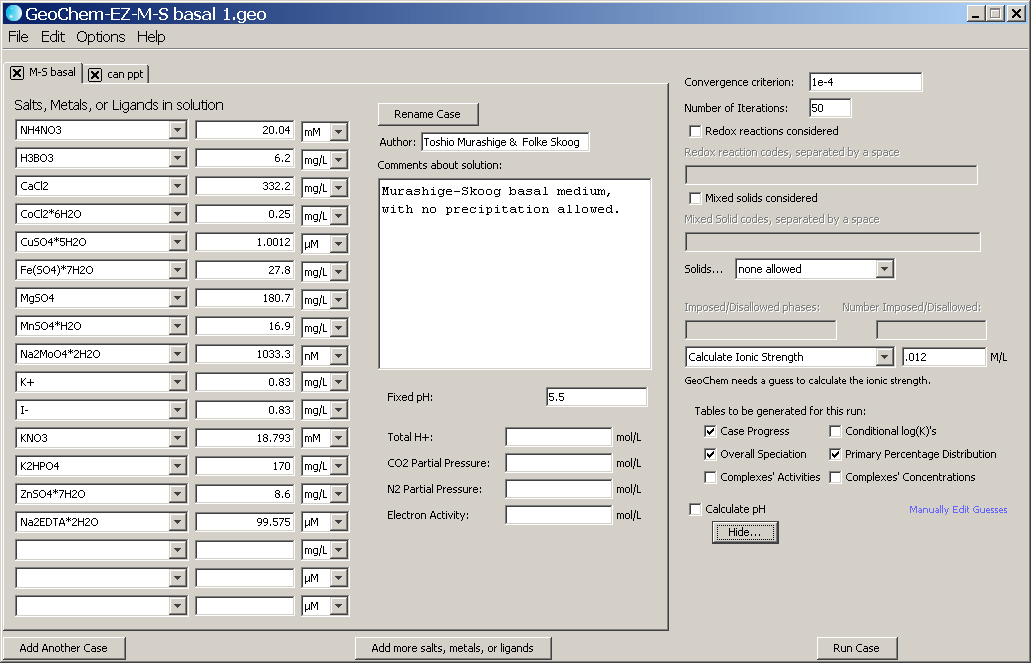Why Should I Use This Program To Design My Experimental Solutions?
Many scientists have adapted standard nutrient solutions for their hydroponics or for their experimental treatments without having analyzed these solutions to see whether any precipitation or solids may form. Geochem-EZ can help predict this.
Others may use this program to design sensible chelate buffer systems or to calculate the concentration of a particular ion needed to provide a constant activity. It is also a good way to know that there is sufficient free activity of important nutrients.
Figure 1 is an example of a Murashige-Skoog Basal Medium, which has been entered into the Geochem-EZ interface. Notice that there are dropdown boxes for the entering the salts, or ions interest. This dropdown list can be easily customized. Concentrations can be entered either as weight per volume (e.g., g L–1) or in molar units.
The program allows the user to consider or disallow precipitation, mixed solids, redox reactions, and CO2 partial pressure. It will calculate the ionic strength and the pH of the solution given the required inputs. Multiple cases can be run. Here there are two cases (M-S basal, can ppt) being analyzed in this run. This is very helpful if one wants to see how varying a parameter (e.g., pH, ion concentration) will affect the ions of interest in the experimental solution.
To show some of the program's strengths, the following example presents the analysis of one of the solutions that is currently being used to investigate aluminum (Al) tolerance in rice.
Many rice lines are fairly Al tolerant and, thus, require higher concentrations of Al in their test solutions in order to elicit root growth inhibition. This higher Al concentration in the nutrient solution leads to ionic interactions that lower the activities of other solution components. As an example, we have analyzed a case with Geochem-EZ in which a researcher used a Yoshida's rice nutrient solution (Yoshida et al., 1972), with pH 4.0 and 1.1 mM (30 ppm) of Al added. Geochem-EZ generates several different output files to help the user analyze the solution and to help them create an improved experimental solution.
When Geochem-EZ analyzes a solution it generates several output tables according to the user's selection. This allows the output to be considered in a number of ways and it increases the power of the analysis. Consider the ways that the output data are shown in the Case Progress and the Primary Distribution tables. Figure 2 shows the Case Progress Output Table for a Yoshida's Rice Nutrient solution, pH 4.0, with 1.1 mM Al (30ppm) added. Solids were allowed to precipitate for this analysis. This output table compares the amount added originally (Total Conc) to what is actually available in solution (Free Activity). What one sees from comparing the total Al concentration with its free activity is that the majority of Al (III)is not free in solution. Much of the aluminum has complexed with sulfate (see under "Solid" at the bottom of the table). Iron (III) is complexing phosphate, so, as a result of these two interactions, both sulfate and phosphate are lowered in the nutrient solution. Conversely, Fe (III) and Al (III) are limited dramatically by their interaction with phosphate and sulfate, respectively. This did not happen in the control solution analysis because Al did not affect the chemistry. Ideally, the treatment solution should only vary in one parameter (Al) relative to the control solution in order to assess its effects on plant growth. This is not the case when comparing these two solutions. Thus, the treatment solution (30 ppm Al) and the control solution are not similar at all in these respects.
The Primary Distribution Table (Fig. 3) shows how a particular ion interacts with the other ions in this Yoshida's solution with Al. For example, citrate (Citr) has complexed almost completely with Al(III). Citrate was added to chelate the Fe (III), so that it would be available to the plants, but that is not happening due to citrate’s stronger interaction with Al (III). As such, citrate is not chelating the Fe(III) and the iron is more available to react with phosphate. However, with a basic Yoshida's nutrient solution (no Al) and thus, no competition for anions by Al, seventy-five percent of the Fe(III) is chelated with citrate and it interacts less with phosphate. The addition of a better iron (III) chelate or more citrate would help to solve this problem.
We hope you find Geochem-EZ to be a valuable tool to optimize your experimental solutions.


